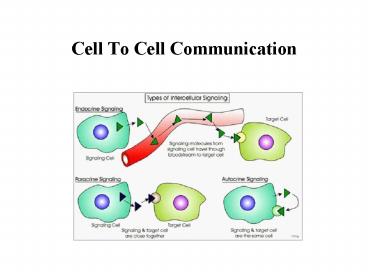Cell To Cell Communication - PowerPoint PPT Presentation
1 / 27
Title:
Cell To Cell Communication
Description:
Cell To Cell Communication * Figure 11.5 Local and long-distance cell signaling by secreted molecules in animals. * Figure 11.5 Local and long-distance cell signaling ... – PowerPoint PPT presentation
Number of Views:283
Avg rating:3.0/5.0
Title: Cell To Cell Communication
1
Cell To Cell Communication
2
Local and Long-Distance Signaling
- Cells in a multicellular organism communicate by
chemical messengers - Animal and plant cells have cell junctions that
directly connect the cytoplasm of adjacent cells - In local signaling, animal cells may communicate
by direct contact, or cell-cell recognition
3
Plasma membranes
Gap junctionsbetween animal cells
Plasmodesmatabetween plant cells
(a) Cell junctions
(b) Cell-cell recognition
4
- Animcal cells communicate using local regulators,
messenger molecules that travel only short
distances - In long-distance signaling, plants and animals
use chemicals called hormones - The ability of a cell to respond to a signal
depends on whether or not it has a receptor
specific to that signal
5
Figure 11.5
Local signaling
Long-distance signaling
Target cell
Electrical signalalong nerve celltriggers
release ofneurotransmitter.
Endocrine cell
Bloodvessel
Neurotransmitter diffuses across synapse.
Secretingcell
Secretoryvesicle
Hormone travelsin bloodstream.
Target cellspecificallybinds hormone.
Local regulatordiffuses throughextracellular
fluid.
Target cellis stimulated.
(a) Paracrine signaling
(b) Synaptic signaling
(c) Endocrine (hormonal) signaling
6
Figure 11.5a
Local signaling
Target cell
Electrical signalalong nerve celltriggers
release ofneurotransmitter.
Neurotransmitter diffuses across synapse.
Secretingcell
Secretoryvesicle
Local regulatordiffuses throughextracellular
fluid.
Target cellis stimulated.
(a) Paracrine signaling
(b) Synaptic signaling
7
Figure 11.5b
Long-distance signaling
Endocrine cell
Bloodvessel
Hormone travelsin bloodstream.
Target cellspecificallybinds hormone.
(c) Endocrine (hormonal) signaling
8
The Three Stages of Cell Signaling Preview
- Cells receiving signals went through three
processes - Reception
- Transduction
- Response
9
Figure 11.6-1
EXTRACELLULARFLUID
CYTOPLASM
Plasma membrane
Reception
Receptor
Signalingmolecule
10
Figure 11.6-2
EXTRACELLULARFLUID
CYTOPLASM
Plasma membrane
Reception
Transduction
Receptor
Relay molecules in a signal transductionpathway
Signalingmolecule
11
Figure 11.6-3
EXTRACELLULARFLUID
CYTOPLASM
Plasma membrane
Response
Reception
Transduction
Receptor
Activationof cellularresponse
Relay molecules in a signal transductionpathway
Signalingmolecule
12
Reception A signaling molecule binds to a
receptor protein, causing it to change shape
- The binding between a signal molecule (ligand)
and receptor is highly specific - A shape change in a receptor is often the initial
transduction of the signal - Most signal receptors are plasma membrane proteins
13
Receptors in the Plasma Membrane
- Most water-soluble signal molecules bind to
specific sites on receptor proteins that span the
plasma membrane - There are three main types of membrane receptors
- G protein-coupled receptors
- Receptor tyrosine kinases
- Ion channel receptors
14
- G-protein-coupled receptor are the largest family
of cell-surface receptors - A GPCR is a plasma membrane receptor that works
with the help of a G protein - The G protein acts as an on/off switch If GDP is
bound to the G protein, the G protein is inactive
Signaling molecule binding site
Segment thatinteracts with G proteins
15
Figure 11.7b
G protein-coupledreceptor
Plasmamembrane
Activatedreceptor
Signalingmolecule
Inactiveenzyme
GTP
GDP
GDP
CYTOPLASM
Enzyme
G protein(inactive)
GTP
GDP
Activatedenzyme
GTP
GDP
P i
Cellular response
16
Figure 11.8
Moleculeresemblingligand
?2-adrenergicreceptors
Plasmamembrane
Cholesterol
17
- Receptor tyrosine kinases (RTKs) are membrane
receptors that attach phosphates to tyrosines - A receptor tyrosine kinase can trigger multiple
signal transduction pathways at once - Abnormal functioning of RTKs is associated with
many types of cancers
18
Figure 11.7c
Signalingmolecule (ligand)
Ligand-binding site
Signalingmolecule
? helix in themembrane
Tyr
Tyr
Tyr
Tyrosines
Tyr
Tyr
Tyr
Tyr
Tyr
Tyr
Tyr
Tyr
Tyr
Tyr
Tyr
Tyr
Tyr
Tyr
Tyr
CYTOPLASM
Receptor tyrosinekinase proteins(inactive
monomers)
Dimer
Activated relayproteins
Cellularresponse 1
Tyr
P
Tyr
P
P
Tyr
Tyr
Tyr
Tyr
P
Tyr
P
Tyr
P
Tyr
Tyr
Tyr
P
Tyr
P
Cellularresponse 2
Tyr
P
Tyr
P
Tyr
Tyr
Tyr
P
Tyr
P
6 ATP
6 ADP
Activated tyrosinekinase regions(unphosphorylate
ddimer)
Fully activatedreceptor tyrosinekinase(phosphor
ylateddimer)
Inactiverelay proteins
19
- A ligand-gated ion channel receptor acts as a
gate when the receptor changes shape - When a signal molecule binds as a ligand to the
receptor, the gate allows specific ions, such as
Na or Ca2, through a channel in the receptor
20
Figure 11.7d
Gate closed
Gate closed
Ions
Gate open
Signalingmolecule (ligand)
Plasmamembrane
Ligand-gatedion channel receptor
Cellularresponse
21
Intracellular Receptors
- Intracellular receptor proteins are found in the
cytosol or nucleus of target cells - Small or hydrophobic chemical messengers can
readily cross the membrane and activate receptors - Examples of hydrophobic messengers are the
steroid and thyroid hormones of animals - An activated hormone-receptor complex can act as
a transcription factor, turning on specific genes
22
Figure 11.9-1
EXTRACELLULARFLUID
Hormone(testosterone)
Plasmamembrane
Receptorprotein
DNA
NUCLEUS
CYTOPLASM
23
Figure 11.9-2
EXTRACELLULARFLUID
Hormone(testosterone)
Plasmamembrane
Receptorprotein
Hormone-receptorcomplex
DNA
NUCLEUS
CYTOPLASM
24
Figure 11.9-3
EXTRACELLULARFLUID
Hormone(testosterone)
Plasmamembrane
Receptorprotein
Hormone-receptorcomplex
DNA
NUCLEUS
CYTOPLASM
25
Figure 11.9-4
EXTRACELLULARFLUID
Hormone(testosterone)
Plasmamembrane
Receptorprotein
Hormone-receptorcomplex
DNA
mRNA
NUCLEUS
CYTOPLASM
26
Figure 11.9-5
EXTRACELLULARFLUID
Hormone(testosterone)
Plasmamembrane
Receptorprotein
Hormone-receptorcomplex
DNA
mRNA
NUCLEUS
New protein
CYTOPLASM
27
Hormone Responses
- Peptide Based Hormones
- Steroid Based Hormones
- Bind to receptors on the cell membrane
- Do not enter cell (polar)
- Induce a cascading effect
- Amino acids
- 2nd messengers
- Rapid speed of effect
- Temporary effect
- Ex Insulin, ADH, calcitonin
- Enter the cell (non polar)
- Receptor is in cytosol of cell or nucleus
- Slower speed of effect
- More permanent effect
- Travel to the nucleus
- Lipids
- Ex Testosterone, estrogen































